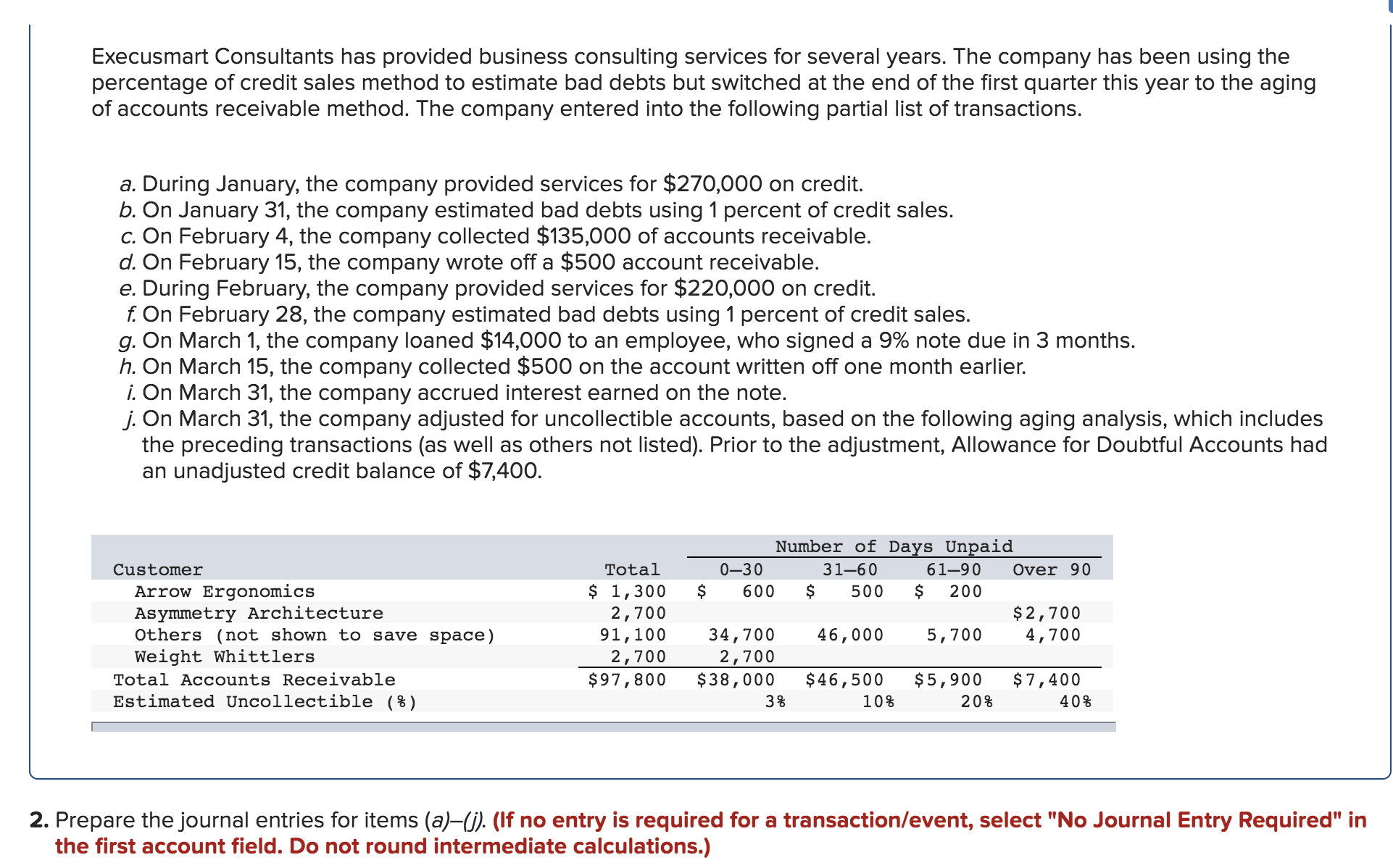Execusmart Consultants has provided business consulting services for several years. The company has been using the percentage of credit sales method to estimate bad debts but switched at the end of the first quarter this year to the aging of accounts receivable method. The company entered into the following partial list of transactions. a. During January, the company provided services for $270,000 on credit. b. On January 31, the company estimated bad debts using 1 percent of credit sales. c. On February 4, the company collected $135,000 of accounts receivable. d. On February 15, the company wrote off a $500 account receivable. e. During February, the company provided services for $220,000 on credit. f. On February 28, the company estimated bad debts using 1 percent of credit sales. g. On March 1, the company loaned $14,000 to an employee, who signed a 9% note due in 3 months. h. On March 15, the company collected $500 on the account written off one month earlier. i. On March 31, the company accrued interest earned on the note. j. On March 31, the company adjusted for uncollectible accounts, based on the following aging analysis, which includes the preceding transactions (as well as others not listed). Prior to the adjustment, Allowance for Doubtful Accounts had an unadjusted credit balance of $7,400. Number of Days Unpaid 0-30 Over 90 31-60 61-90 Customer Total $ 1,300 2,700 91,100 2,700 $97,800 Arrow Ergonomics Asymmetry Architecture Others (not shown to save space) Weight Whittlers 600 500 200 $2,700 4,700 34,700 2,700 $38,000 46,000 5,700 Total Accounts Receivable $46,500 $5,900 $7,400 Estimated Uncollectible (%) 3% 10% 20% 40% 2. Prepare the journal entries for items (a)-(j). (If no entry is required for a transaction/event, select "No Journal Entry Required" in the first account field. Do not round intermediate calculations.)
The Effect Of Prepaid Taxes On Assets And Liabilities
Many businesses estimate tax liability and make payments throughout the year (often quarterly). When a company overestimates its tax liability, this results in the business paying a prepaid tax. Prepaid taxes will be reversed within one year but can result in prepaid assets and liabilities.
Final Accounts
Financial accounting is one of the branches of accounting in which the transactions arising in the business over a particular period are recorded.
Ledger Posting
A ledger is an account that provides information on all the transactions that have taken place during a particular period. It is also known as General Ledger. For example, your bank account statement is a general ledger that gives information about the amount paid/debited or received/ credited from your bank account over some time.
Trial Balance and Final Accounts
In accounting we start with recording transaction with journal entries then we make separate ledger account for each type of transaction. It is very necessary to check and verify that the transaction transferred to ledgers from the journal are accurately recorded or not. Trial balance helps in this. Trial balance helps to check the accuracy of posting the ledger accounts. It helps the accountant to assist in preparing final accounts. It also helps the accountant to check whether all the debits and credits of items are recorded and posted accurately. Like in a balance sheet debit and credit side should be equal, similarly in trial balance debit balance and credit balance should tally.
Adjustment Entries
At the end of every accounting period Adjustment Entries are made in order to adjust the accounts precisely replicate the expenses and revenue of the current period. It is also known as end of period adjustment. It can also be referred as financial reporting that corrects the errors made previously in the accounting period. The basic characteristics of every adjustment entry is that it affects at least one real account and one nominal account.
Prepare the

Trending now
This is a popular solution!
Step by step
Solved in 2 steps with 2 images









